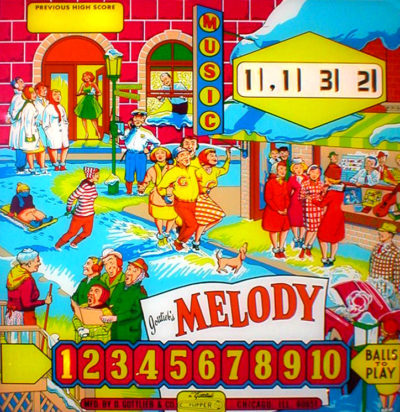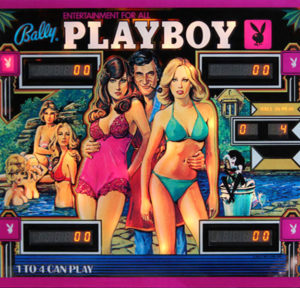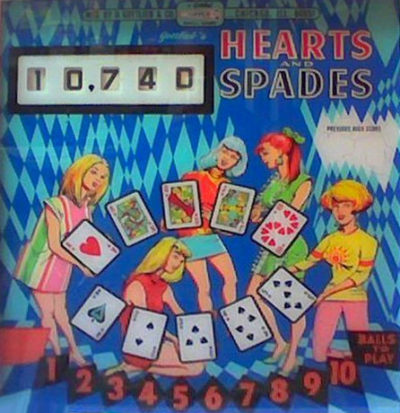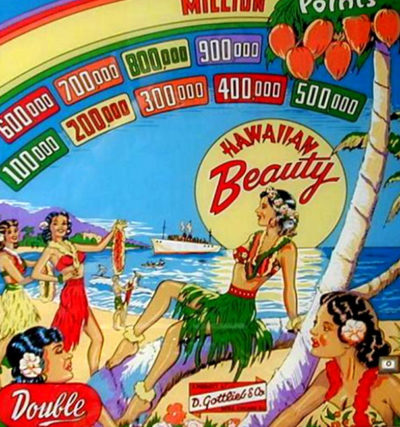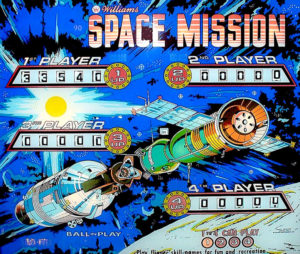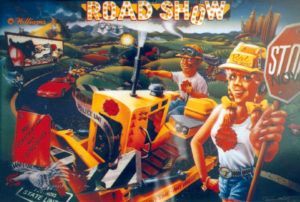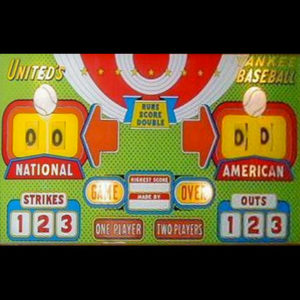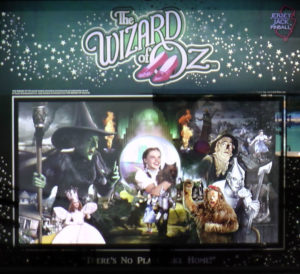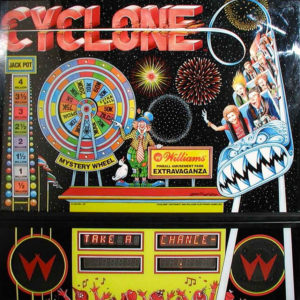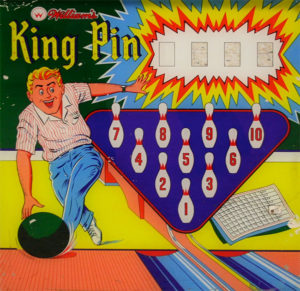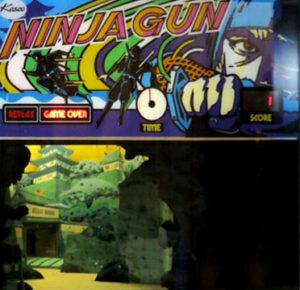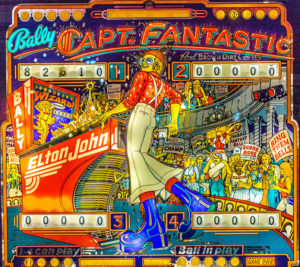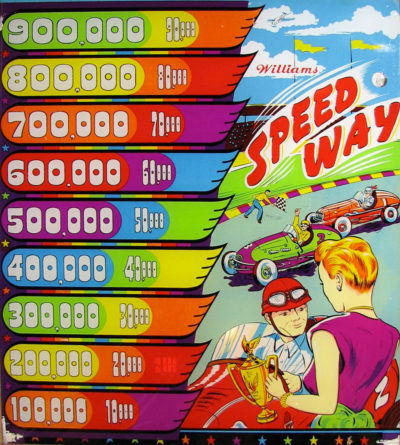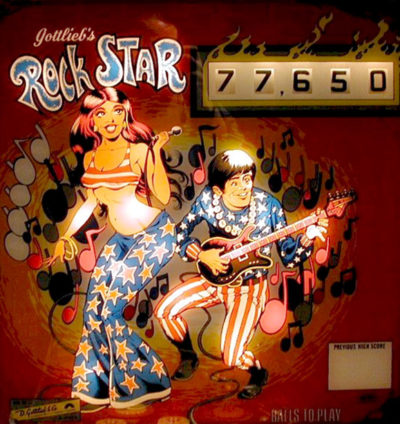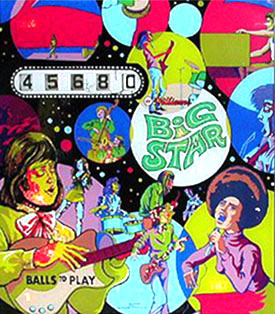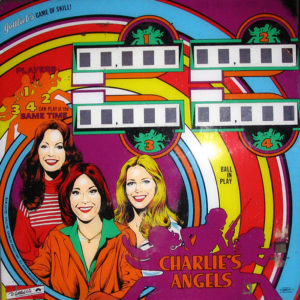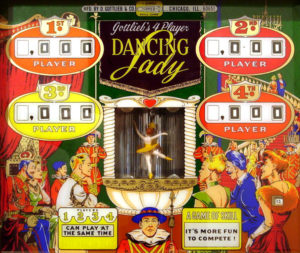-
Pro Pool originated in December with 800 units being fabricated. This add-a-ball machine was designed by Ed Krynski with artwork by Gordon Morison. Two replay versions of the game were also made: a two-player version called Big Shot and a four-player version called Hot Shot. Obviously the theme of this game is the game of pool. The playfield is symmetrical and the way to win extra balls is by completing the left and/or right drop target battery. Doing so will lift the left and/or right wow rollovers for this award. The drop targets reset once the sequences are completed. Of course, an operator-adjusted score is another way to score a couple of balls. Back in the ‘70s, multiple balls or replays could be achieved on the game. Today, one free game on a current solid-state game is the common win. Operators have made it harder to achieve free games today as free games yield no income and only result in down time for the machine to earn coins in the till.This game is the pinball rendition of the HBO TV show, The Sopranos, complete with voices of most of the actors in the series. It was designed by George Gomez with the art package created by Kevin O’Conner. The main object of the machine is to advance through the ranks of the mob by advancing your status through playfield rollovers and cracking the safe. Doing so is difficult to achieve to top capo. A multiball feature is also incorporated into the game behind a solo drop target. Video modes must be achieved to complete the placard of events culminating in the completion of your missions. So many pop bumper hits light up the party at the bing in the upper right, which scores a bunch of points. Mastering this machine is tough, but that’s what brings you back to try again.October was the birthdate for this machine. It was designed by Ed Krynski with artwork by Art Stenholm. Low production run of 550 units. This is an add-a-ball game, the replay version being called Sing Along. This game was a variation on a classic Gottlieb game Kings and Queens, in that it contains the four side-by-side kickout holes made popular in 1965. Here, the object of the game is to complete four same-colored numbers vertically in a row to randomly cause the kickout hole to light to score an extra ball if you land in the hole when it’s lit. If you didn’t win a ball, each light in the column would award 10 points. If you have most of the lights lit, a run at the kickout holes awards a lot of points in a hurry which, in this game, also awards extra balls. One center target is also incorporated into the game, awarding 100 points when hit and lights the pop bumpers for higher scoring.This solid-state game was very popular when it was released and has a lot of smooth shots to complete. It was designed by Jim Patla with artwork by Paul Faris. Production run was 18,250 units. This pre-speaking pinball has Hugh Hefner on its backglass with Bunny Sondra Theodore posing. At the top of the game are four rollover lanes, which advance when hit to a special and advance the bonuses and grotto award. Hitting the five Bunny targets also advance a feature to win extra balls and specials. A unique kickback lane advances with every entrance into it. A five-pack of drop targets also advance certain features on the game. If 20,000 points are made on the bonus system, this point count is carried over to all remaining balls and then some. The nicest shot on the game is going up the right side from the flipper and looping the ball into the grotto. The sound originates from the old TV show “Playboy After Dark.”If there was a very pretty game manufactured in the ‘50s, this is it! Hawaiian Beauty was designed by Wayne Neyens with art package by none other than Roy Parker. 900 of these machines were screwed together in the Chicago factory. The game was initially called “Monkey Shine” but was later changed. This game also features the infamous “double” award. If you inset two nickels at the beginning of the game instead of the usual nickel, each won replay would score two games or double the winnings instead of one game. More coins in the coinbox was the hope of the arcade owners. The playfield is interesting in this game. Two blocked gobble holes at the top of the playfield would score 500,000 points and light lower side exit special lanes for replays. Hitting the 1-6 sequence at the top of the playfield would advance the rollovers to score 100,000 points if rolled over. Points as well as score won games.Space Mission was released in January, designed by Steve Kordek with artwork by Christian Marche. Production run was 11,652. This game was very successful for Williams and is considered to be the seventh most desirable game of the ’70s era.The game features a moving target as well as two side kickers next to the flippers for shots at the moving target. Making the A, B, or C light up the side eject holes to award a double bonus for the ball in play. If you were skillful enough to complete the A, B and C, the side outlanes light up for special. The top horshoe loop advances the bonus system. This game has a lot of nice shots and is fast paced. One doesn’t tire easily trying to achieve the scores needed to win a free game. This game was one of Steve’s Kordek’s favorite designs.This wide-body mouthful of a game incorporates not one talking head (like in the game “Funhouse”) but two…and they talk to each other during game play. Williams made around six wide-body machines such as this so as to incorporate more real estate space for playfield action and toys. They went by the moniker of the “Super Pin.” This machine was designed by Pat Lawlor and inked by John Youssi. 6,259 were made. In a nutshell, the object of this machine is to cross the US to achieve the ultimate jackpot round. Each time you hit Ted, the day of the week advances in front of him. When you reach Friday, it’s payday. This starts the three-ball multiball series. The jackpot is achieved when you shoot a ball into sleeping Ted’s mouth! Much mayhem, a vibrating motor, two plunger shots, and a lot of characters pop up to taunt you on your way across the country. Country singer Carlene Carter is the voice of Red.Williams produced this game in October with 7,053 units produced. Norm Clark designed the game and Christian Marche did the art package. This four-player electromechanical game is based on the game tic-tac-toe. Making 3 x’s or 3 o’s in line or diagonally lights the eject holes to award an extra ball and 5,000 points. Making the A and B rollovers lights the center target. Hitting it opens the gate and 1,000 points. A bonus feature is incorporated into the game and this is awarded when the ball drains. Lighting all the squares activates the side rollover lanes to score a replay. Score and matching are also incorporated into the game. A fast playfield design and fun to play.Wow! What a light show! The machine before you represents the first offering from the fledgling company of Jersey Jack Pinball of Lakewood, N.J. A pinball of any production hasn’t been made in the state for decades. This machine was created as a centerpiece of technology to show the arcade world what a contemporary machine can contain in one package. Stern, the only other U.S. maker of pinball, has always streamlined the process of pinball manufacturing and kept the number of pinball “toys” on a machine to a minimum to make their machines less expensive. Since this machine came out, Stern now offers three models of their newer machines: a stripped basic unit, an average machine contents wise and a tricked-out collectable unit to compete with the likes of Jersey Jack. Look at this machine! Mike Balcer designed the playfield; Jerry Vandersteldt, Greg Freres and Matt Riesterer penned the artwork. 1,000 units are already spoken for and both a special edition (the one here) and a standard edition are planned. Five flippers, five magnets, color changing LEDs, a 26-inch LED monitor, shaker motor, ball lift, spinning house toy, crystal ball projector, rising witch and wide-body package are only some of the innovations seen here.Gottlieb released the game “Sinbad” in both solid-state and electromechanical formats in June of the year. Designed by Ed Krynski with art by Gordon Morison, there were 12,000 S.S. games and 950 E.M. games made. This machine is the rare two-player version of the game, of which 730 were made. Drop targets are the main theme of this game. Knocking down the single white drop target awards a 2x bonus and lights the white rollover. The three yellow drops were next. If hit, 3x bonus is awarded when the ball drains and the 5,000 rollover lights at the top of the playfield. The four purple drops were next. Making these would award 4x bonus and light the extra ball rollover. Finally, the five red drops; when hit would award 5x bonus (the maximum bonus that could register is 15,000 points times the bonus) as well as light the special rollover. Four flippers allowed for interesting play, also.This machine is one in a trilogy that Williams produced with an amusement park theme. 9,400 were made with design accolades going to Barry Oursler and art by Python Anghelo. Ronald and Nancy Reagan appear on the backglass. The Comet and Cyclone are two roller coasters from the Coney Island era. If you ride the Comet ramp six times, a million-point shot is possible. The Cyclone ramp in the upper right awards the accumulated jackpot on the backglass if hit three times. Hitting the spook house drop target exposes a gobble hole which spins the backglass wheel for a point award or extra ball. A ferris wheel bonus a shooting gallery bonus and a bonus multiplier shot in the lower left complete this impressive package. “You pay your money, you take your chances” in this classic machine.Kasco Manufacturing Company produced about eight machines of various themes in their productive commercial life. This machine is the most popular of the games they made. This shoot’em up game awards a free play if a score of 80 is made. The game board is elaborate for its day and looks 3-D. Blacklight, holograms, and mechanical chain link drives are all synchronized at different speeds (the faster the ninja moves, the more potential points you can earn if you hit one). Hitting a ninja produces a flash of light and points. Audio enhances your experience. Lighting colored artwork from behind a mirror creates the animation effect seen in this game. There’s only eight molded targets in the game, but it appears a lot more are present due to the computer’s timing of their action. Give it a shot!This game is considered to be the #3 game of the ’70s. It was released in June, designed by Greg Kmiec and art by Dave Christiansen. It had a production run of 16,200 units, a record to that date for production by Bally. The game has a rock star tie in the form of Elton John, who was at his peak back then. The movie “Tommy” was also an influence for the game’s graphics. The triple flipper arrangement of the game made for fast action on the playfield. A bonus feature is present, a 5-bank drop target that when hit, advances through extra ball and then special. A free ball gate, when activated, extends the ball’s life. This game is one of the last most collectible electromechanical-era games produced. It was the complementary game to Bally’s Wizard pinball which, again, found its theme based on the “Tommy” movie by The Who. Celebrity tie-ins were found to be big sellers.This machine is based on the ’30s radio series then turned into a movie. Design accolades go to Brian Eddy with art scripted by Doug Watson. 4,247 of these machines were made. The interesting feature in this machine is the elevated upper-left playfield. This playfield is gained access to once the drop target is hit. Once this challenge is complete, another shot to this ramp shoots the ball upstairs to this feature. Pressing the flipper buttons moves the paddle left or right. The kicker is activated by an optic sensor automatically to hit all the targets if your aim is sure. This game also has a thrust magnet which grabs the ball in action and shoots it up the playfield into the next feature. No pop bumpers are on the playfield, which is a rare event. Another first incorporated into this playfield are two ramp diverters which are player adjustable. Completing the six scenes of the story award you with the final battle sequence of good against evil.The game before you is extremely rare with only 278 screwed together at the Chicago Gottlieb factory. This one-player electromechanical add-a-ball game was designed by John Osbourne with art by Gordon Morison. A replay version was also designed by the name of Blue Note. The object of this machine is to complete all the notes down the left side of the playfield. Doing so activates the classic “wow” feature which, when hit, awards one free ball. A reset is in your future once your current ball drains. Score is another way to achieve longer play by winning extra balls. The spinner in the middle of the playfield awards big points when 1,000 points is lit; each spin of the target awards 1,000 points plus number of revolutions spun. A nice retro art package completes this rare machine.This one-player September release was designed by Steve Kordek with art package laid out by Christian Marche. 1,130 units were made, which is a pretty low production run. This is an add-a-ball game with a replay version also released called “Superstar.” This machine incorporates not one but three pop-up posts to deflect the ball from draining through the side drains as well as the flipper drain. The object of the machine is to extend your playing time by winning more free balls. This is achieved by completing the s-u-p-e-r roll-overs at the top of the play field. Doing so lights the hidden center kick-out hole. By dropping the target in front of this hole, one has a shot at the extra ball prize. If both specials are lit, two free balls are awarded. Completing each five-star sequence also advances the center shot award. Score is another to earn extra balls per game. Replay games were much more popular back in this era, but not every locale allowed replays.This four-player machine was produced in November of the year with 2,675 units fabricated. It was designed by Ed Krynski with art penned by Art Stenholm. Technically, a couple of firsts were incorporated into this machine for Gottlieb, like an automatic ball lifter, decagon score reels and carousel roto-targets. The carousel roto-target allow one to shoot at one or two targets at a time if flipper savvy. The star on the unit awards an extra ball. The object of the game is to achieve high-enough scores to award replays. The big points are awarded when the two 10x lights under a roto-target light up, awarding 100 times the value of the number hit. The most attractive gadget built into the game is the dancing ballerina in the backglass, which dances when certain elements of the play field are achieved. A highly collectible game in its own right.
-
Pro Pool originated in December with 800 units being fabricated. This add-a-ball machine was designed by Ed Krynski with artwork by Gordon Morison. Two replay versions of the game were also made: a two-player version called Big Shot and a four-player version called Hot Shot. Obviously the theme of this game is the game of pool. The playfield is symmetrical and the way to win extra balls is by completing the left and/or right drop target battery. Doing so will lift the left and/or right wow rollovers for this award. The drop targets reset once the sequences are completed. Of course, an operator-adjusted score is another way to score a couple of balls. Back in the ‘70s, multiple balls or replays could be achieved on the game. Today, one free game on a current solid-state game is the common win. Operators have made it harder to achieve free games today as free games yield no income and only result in down time for the machine to earn coins in the till.





